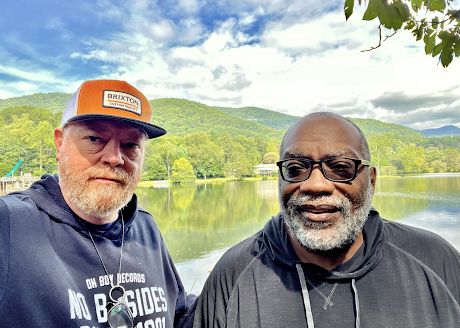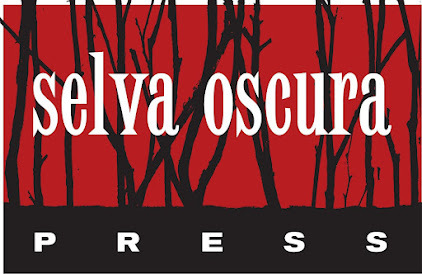12 or 20 (small press) questions with Ken Taylor and Fred Moten on selva oscura press

Fred Moten lives in New York with hiscomrade, Laura Harris, and their children, Lorenzo and Julian. He works in theDepartments of Performance Studies and Comparative Literature at New YorkUniversity.
Ken Taylor is the author of three booksof poetry, two chapbooks, three plays, and a collaborative work with twelveartists. found poem(s), with Ed Roberson, is forthcoming from Corbett vs.Dempsey—Ken’s photographs and Ed's poems.
1 – When did selva oscura press firststart? How have your original goals as a publisher shifted since you started,if at all? And what have you learned through the process?
We want to publish books that we loveby writers whom we love. We are especially glad to publish first books and toimagine that these will be platforms that can propel their authors onto atrajectory in which their work will continue to be seen and heard. We also loverecovering and making available older texts that have fallen out of print andoff the map. And we are committed to seeking out and finding and publishing thework of black authors, authors of color, and queer and trans authors. We havebeen primarily focused on poetry, but we have been branching out into fictionand non-fiction prose and have some plays forthcoming, as well. We areespecially committed to making sure that the authors love the way their bookslook and so we are especially happy to work with authors who know how they wanttheir books to look.
2 – What first brought you topublishing?
In the Research Triangle of NorthCarolina, we were part of a great community of writers which included ShirletteAmmons, Joseph Donahue, Nathaniel Mackey, Pete Moore, Kate Pringle, Ken Rumbleand Magdalena Zurawski (among many others), all of whom had made it theirbusiness to serve the community by providing venues for people to read andpublish. We wanted to follow their example. Three Count Pour and selva oscuraemerged from that desire.
3 – What do you consider the role andresponsibilities, if any, of small publishing?
Get the word and the work out.
4 – What do you see your press doingthat no one else is?
There are so many presses servingpoetry in so many ways. Not sure we’re a step above or beyond. We lean intocollaboration. Listen. Are renewed with new enthusiasms that come our way withnew and established work.
5 – What do you see as the mosteffective way to get new books out into the world?
Lately it’s been Asterism Books. Theyhave been a godsend since SPD shuttered.
6 – How involved an editor are eitherof you? Do you dig deep into line edits, or do you prefer more of a lighttouch?
Our touch is very light. We don’t doline edits. We find books and writers that we like and trust them to get it howthey want it. We try to help them find that if they want or need us to.
7 – How do your books get distributed?What are your usual print runs?
Runs depend on the author. 200-400.Asterism Books is our new distributor. They do a good job at stuff we’re notmuch good at. We don’t have a lot of resources for promotions but try and helpwith at least one launch reading for each author.
8 – How many other people are involvedwith editing or production? Do you work with other editors, and if so, howeffective do you find it? What are the benefits, drawbacks?
We keep it pretty close. Our copyeditor(Miles Champion) and our designer (Margaret Tedesco) do the lion share of thework in terms of grind and production. The benefits are that they are bothbadassed. No drawbacks yet.
9 – How has being an editor/publisherchanged the way you think about your own writing?
We both get to keep our heads in thegame. If we’re excited about something to publish, it usually inspires us towrite.

10 – How do you approach the idea ofpublishing your own writing? Some, such as Gary Geddes when he still ranCormorant, refused such, yet various Coach House Press’ editors had titlesduring their tenures as editors for the press, including Victor Coleman and bp Nichol.What do you think of the arguments for or against, or do you see the wholequestion as irrelevant?
We’re not against it. We areprincipally focused on the work of others. We’ve talked about various projectswe’ve done that might work for selva oscura or Three Count Pour, and alsodiscussed supporting that work financially through other presses.
11 – How do you see selva oscura pressevolving?
One thing we want to do is get back todoing chapbooks, through our subprint/imprint Three Count Pour. Maybe that’s alittle bit more like revolving than evolving. We’d like to do them in smallbundles, like the Durham Suite that we published years ago, combiningwell-known and less well-known writers in one package. And we’d like thechapbooks to be art books. We want the book actually to be necessary, somethingheld in the hand as that which couldn’t have been any other way. This meansthat the writers will work in co-accompaniment with the book designer as wellas with visual artists.
12 – What, as a publisher, are you mostproud of accomplishing? What do you think people have overlooked about yourpublications? What is your biggest frustration?
I don’t think there have been any bigfrustrations. I think we both hope and intend to do a better and better job ofpromoting the books and supporting them after publication. The idea is not onlyto have a palpable and beautiful document of the work the authors do but alsoto get the books in the hands of sensitive, generous, and enthusiastic readers.
13 – Who were your early publishingmodels when starting out?
Initially it was chapbooks, and then anart/poetry collaboration, with the aim to add beautiful objects to the historyof folks doing this. We’ve haven’t tried to emulate any model specifically.
14 – How does selva oscura press workto engage with your immediate literary community, and community at large? Whatjournals or presses do you see selva oscura press in dialogue with? Howimportant do you see those dialogues, those conversations?
We just want to be working in concertwith, and be part of the complementary variety of, the community that is givento the general field of poetry, which we tend to think of, by way of Juliana Spahr, as “this connection of everyone with lungs.” We’re not picky and we’rehere militantly to mess with anyone who is so that the conversation can stayinfinite and real.
15 – Do you hold regular or occasionalreadings or launches? How important do you see public readings and otherevents?
We have had launches and readings foralmost all of the books and will do so for all the authors who desire that. ThePandemic but a temporary hold on that but we are now trying to catch up, and wewill. It’s important to get the sound of this writing into the world.
16 – How do you utilize the internet,if at all, to further your goals?
We have a web site, and social mediahandles, send out invites, but not working the internet much beyond that.That’s largely dictated by the time we have available.
17 – Do you take submissions? If so,what aren’t you looking for?
We don’t take unsolicited submissions.
18 – Tell me about three of your mostrecent titles, and why they’re special.
To Regard a Wave, by Sora Han, weaves physics andtranslation, translation and weaving, in a beautiful meditation on love andrevolution; Arvo Villars’s Violently Dancing Portraits can’t sit still,teaches how to withstand immersion in (im)migrant energy, kinda like Creole’s –aka Kreyól’s – blues as it pulses under Sonny’s (for all you beautiful Baldwinfans); and, in Shekhinah Speaks, Joy Ladin offers a prophetic transtheology that’s radical as every day.



